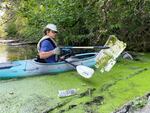
Paul Taylor, pictured on June 22, 2023, has spent the last three years taking trash out of the Columbia Slough. He keeps a spreadsheet: “I’ve pulled out 150 tires, 65 propane tanks, 650 needles, 5,000 cans ... That’s how I fund my operation, with the cans.”
Kristian Foden-Vencil / OPB
When COVID hit, retired programmer Paul Taylor decided to kayak the Columbia Slough.
It’s a 19-mile stretch of water that strings together some of Portland’s most polluted industrial sites.
Most of it is not even a natural river. The slough used to be a marsh, where Native American tribes hunted. In the 1900s, farmers dug dikes, draining the land and creating the slough.
Nowadays, the waterway is largely hidden by a row of cottonwoods. But drivers can catch a glimpse on their way to the Fazio Landfill, Columbia Boulevard Wastewater Treatment Plant or Portland International Airport.
But when Taylor went kayaking, he was amazed by some of the beautiful hidden spots he found.
“The only drawback to it was there was so much trash in the water and along the banks that it didn’t really feel like a pleasant experience,” he said.
If you’ve ever seen a guy in Northeast Portland schlepping a kayak on a bike, that’s probably Taylor.
“I figure it’s the dream of every piece of trash on Cornfoot Road to make its way into the slough and out to the great Pacific trash patch,” he said.
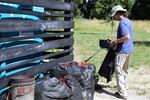
Paul Taylor piles his collected trash where the SOLV Adopt-a-River program will come to pick it up, on June 22, 2023.
Kristian Foden-Vencil / OPB
Over the last three years, Taylor has kept a spreadsheet of everything he’s collected: “I’ve pulled out 150 tires, 65 propane tanks, 650 needles, 5,000 cans. That’s how I fund my operation, with the cans.”
Taylor’s operation is really just him buying trash bags and taking part in the SOLV Adopt-a-River program.
Marginalized communities find their voice
Various cleanup efforts along the slough have paid off. At the Whitaker Ponds stretch, you can see fish, insects, herons and plants in crystal clear water.
People generally stopped dumping things into the slough back in the 1970s. But the cleaning didn’t start in earnest until the 1990s and 2000s.
Heather King, executive director of the Columbia Slough Watershed Council, said that’s when people who called the area home — many of them lower income or from historically marginalized communities — found a voice.
“(They) spoke up.. loud enough for officials to listen, ‘Hey, this waterway is in our backyard. And what’s happening to it is not OK. And you’ve got to help us clean it up,’” she said
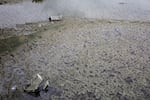
A shopping cart protrudes from the Columbia Slough on June 22, 2023.
Kristian Foden-Vencil / OPB
For years, the slough has been the unwanted stepchild of Portland’s waterways. Even the name conjures a swampy canal.
“When I first took my job,” King said, “my friends were like: ‘What’s a slough?’ And when you look it up in the dictionary it says swamp.”
They would send her memes of Shrek, the cartoon ogre who lived in a swamp.
“‘Oh, you’re working for Shrek.’ And I’m like, ‘Listen, it’s not a swamp,’” she said. “A slough is a series of slow-moving waterways, which is exactly what this is, right?”

Heather King, the executive director of the Columbia Slough Watershed Council, on July 10, 2023.
Kristian Foden-Vencil / OPB
Hidden pollution in slough sediment
The slough’s water is cleaner now. The trouble is, the water and the trash are only part of the problem.
Tons of industrial chemicals still lie in the sediment, where bugs dig down, absorb them and introduce them into the food chain.
Of the 26 industrially polluted sites along the slough’s banks, the Oregon Department of Environmental Quality has cleaned up 10 since 2005.
Seven others are ready for cleanup. And another nine need more study to determine whether cleanup is needed. Sarah Miller, sediment manager with the Oregon Department of Environmental Quality, said they’re making progress.
“Of the known sites, we’re about 50% of the way there, which is good progress.”
That’s considering the comingling of pollution sources and the overall complexity of the work.
“These are very complicated and take a long time to do,” Miller said.
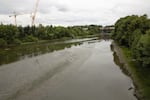
The Columbia Slough is surrounded by industrial sites. Of the 26 industrially polluted sites along its banks, the Oregon Department of Environmental Quality has cleaned up 10 since 2005. Pictured on July 10, 2023.
Kristian Foden-Vencil / OPB
Just how complicated can be illustrated by looking at just one spot, the Pacific Carbide site northeast of the St. Johns neighborhood. The Environmental Protection Agency just awarded $1 million to help clean it up.
Pacific Carbide used to manufacture calcium carbide, which is used in fertilizers, steel and acetylene gas. The process required stockpiling calcium oxide on site.
Every time it rained heavily, some of that calcium oxide trickled into the water, forming a cement-like layer.
“It extends quite a ways down,” said Josh Elliott, a bio-remediation engineer with Maul Foster Alongi, the company contracted to clean up the area under Oregon DEQ oversight.
“They had a furnace, heating up (calcium oxide), and then they had scrubbers,” he said. “And so the wet scrubbers had discharge ponds and those overflowed into the slough as well.”
There are essentially three ways to clean up the mess: dig it out; sprinkle it with activated carbon, which acts as a kind of sponge to absorb contaminants; or the plan DEQ is going with to cover it with a lining and leave it alone.
“It’s much more cost efficient than digging that out and sending it off to a landfill somewhere,” Elliott said.

Josh Elliott, left, a bio-remediation engineer with Maul Foster Alongi, sets up a map of the cleanup plan along the Columbia Slough on July 10, 2023.
Kristian Foden-Vencil / OPB
According to DEQ, Pacific Carbide is contributing about half a million dollars to the project, in addition to having previously performed upland source control. Another half million dollars will come from the Oregon DEQ’s Columbia Slough Sediment Settlement Fund, which is financed through settlements between the state and potentially liable parties.
Pollution like what’s been found at the Pacific Carbide site is one reason the City of Portland gave the slough a failing grade for the safety of its fish and wildlife.
Locals increasingly enjoy the slough, despite toxic sediments
With cleaner water and less trash, many locals are now enjoying the slough.
“This has definitely improved within my lifetime for sure,” paddleboarder Deion Deo said on a recent sunny evening. “Born in 1996, and I remember it was pretty bad in middle school, high school.”

Ilena Allen-Deo and Deion Deo paddleboard along the Columbia Slough on July 18, 2023. “This has definitely improved within my lifetime for sure. Born in 1996, and I remember it was pretty bad in middle school, high school.”
Kristian Foden-Vencil / OPB
His wife, Ilena Allen-Deo, remembers fishing the slough with her dad. The city posts warnings not to eat more than one local filet a month. But many people ignore those notices.
“They literally have to soak the fish in the bathtub for days before deciding to actually prepare it and eat it,” Deo said.
After decades of cleanup, it’s tempting to wonder whether the slough might one day be a place where people pay a premium to live next to the water.
“I would be surprised if it was like Lake Oswego,” said Allen-Deo. “That would be very nice, but that’s kind of far-reaching.”
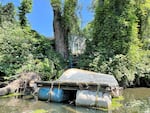
The Columbia Slough, pictured on June 22, 2023, could become desirable real estate as it continues to be cleaned up.
Kristian Foden-Vencil / OPB
Deion hopes the slough might eventually look like the Tualatin River: “It’s gorgeous over there.”
Further along the slough, Paul Taylor has just collected an old tire, a slimy dog kennel and a plastic bucket, which are all balanced precariously on his kayak. He’d rather not see the slough become desirable waterfront property.
“I would like to see us actually have a greater barrier between the slough and our residences and industrial areas, where trees provide shade and habitat for a healthy waterway,” he said.
But whether it resembles the Tualatin River or Lake Oswego, parts of the Columbia Slough are already beautiful wildlife and recreational havens.
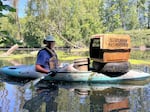
Paul Taylor, pictured on June 22, 2023, has trash piled atop his kayak.
Kristian Foden-Vencil / OPB
